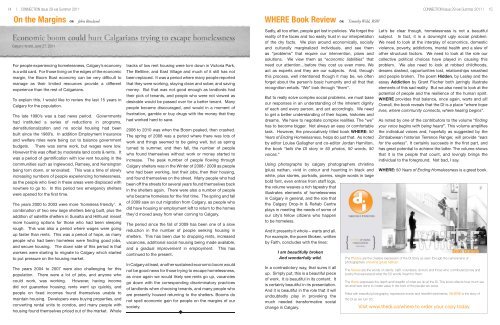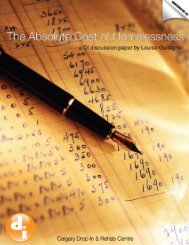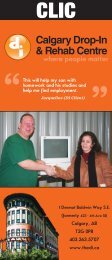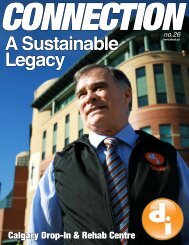Summer 2011.indd - Calgary Drop-In & Rehab Centre
Summer 2011.indd - Calgary Drop-In & Rehab Centre
Summer 2011.indd - Calgary Drop-In & Rehab Centre
You also want an ePaper? Increase the reach of your titles
YUMPU automatically turns print PDFs into web optimized ePapers that Google loves.
14 | CONNECTION Issue 29 <strong>Summer</strong> 2011<br />
CONNECTION Issue 29 <strong>Summer</strong> 2011 | 15<br />
On the Margins John Rowland<br />
For people experiencing homelessness, <strong>Calgary</strong>’s economy<br />
is a wild card. For those living on the edges of the economic<br />
margin, the Boom Bust economy can be very difficult to<br />
manage as their limited resources provide a different<br />
experience than the rest of Calgarians.<br />
To explain this, I would like to review the last 15 years in<br />
<strong>Calgary</strong> for the population.<br />
The late 1990’s was a bad news period. Governments<br />
had instituted a series of reductions in programs,<br />
deinstitutionalization and no social housing had been<br />
built since the 1980’s. <strong>In</strong> addition Employment <strong>In</strong>surance<br />
and welfare roles were being cut to balance government<br />
budgets. There was some work, but wages were low.<br />
However this was offset by moderate land costs & rents. It<br />
was a period of gentrification with low rent housing in the<br />
communities such as <strong>In</strong>glewood, Ramsey, and Kensington<br />
being torn down, or renovated. This was a time of slowly<br />
increasing numbers of people experiencing homelessness,<br />
as the people who lived in these areas were displaced with<br />
nowhere to go to. <strong>In</strong> this period two emergency shelters<br />
were opened for the first time.<br />
The years 2000 to 2003 were more ‘homeless friendly’. A<br />
combination of two new large shelters being built, plus the<br />
addition of satellite shelters in Sunalta and Hillhurst meant<br />
more housing options for those who had been sleeping<br />
rough. This was also a period where wages were going<br />
up faster than rents. This was a period of hope, as many<br />
people who had been homeless were finding good jobs,<br />
and secure housing. The down side of this period is that<br />
workers were starting to migrate to <strong>Calgary</strong> which started<br />
to put pressure on the housing market.<br />
The years 2004 to 2007 were also challenging for this<br />
population. There were a lot of jobs, and anyone who<br />
could work, was working. However, having income<br />
did not guarantee housing; rents went up quickly, and<br />
people on fixed incomes found themselves unable to<br />
maintain housing. Developers were buying properties, and<br />
converting rental units to condos, and many people with<br />
housing found themselves priced out of the market. Whole<br />
tracks of low rent housing were torn down in Victoria Park,<br />
The Beltline, and East Village and much of it still has not<br />
been replaced. It was a period where many people reported<br />
that they were working, staying clean and sober, and saving<br />
money. But that was not good enough as landlords had<br />
their pick of tenants, and people who were not viewed as<br />
desirable would be passed over for a better tenant. Many<br />
people became discouraged, and would in a moment of<br />
frustration, gamble or buy drugs with the money that they<br />
had worked hard to save.<br />
2008 to 2010 was when the Boom peaked, then crashed.<br />
The spring of 2008 was a period where there was lots of<br />
work and things seemed to be going well, but as spring<br />
turned to summer, and then fall, the number of people<br />
who found themselves without work or money started to<br />
increase. The peak number of people flowing through<br />
<strong>Calgary</strong> shelters was in the Winter of 2008 / 2009 as people<br />
who had been working, lost their jobs, then their housing,<br />
and found themselves on the street. Many people who had<br />
been off the streets for several years found themselves back<br />
in the shelters again. There were also a number of people<br />
who became homeless for the first time. The spring and fall<br />
of 2009 saw an out migration from <strong>Calgary</strong>, as people who<br />
did have housing or employment left to return to the homes<br />
they’d moved away from when coming to <strong>Calgary</strong>.<br />
The period since the fall of 2009 has been one of a slow<br />
reduction in the number of people seeking housing in<br />
shelters. This has been due to dropping rents, increased<br />
vacancies, additional social housing being made available,<br />
and a gradual improvement in employment. This has<br />
continued to the present.<br />
<strong>In</strong> <strong>Calgary</strong> at least, another sustained economic boom would<br />
not be good news for those trying to escape homelessness,<br />
as once again we would likely see rents go up, vacancies<br />
go down with the corresponding discriminatory practices<br />
of landlords when choosing tenants, and many people who<br />
are presently housed returning to the shelters. Booms do<br />
not spell economic gain for people on the margins of our<br />
society.<br />
<br />
WHERE Book Review Timothy Wild, RSW<br />
Sadly, all too often, people get lost in policies. We forget the<br />
reality of the faces and too easily trust in our interpretation<br />
of the dry facts. We plan around economically, socially<br />
and culturally marginalized individuals, and see them<br />
as “problems” that require our intervention, plans and<br />
solutions. We view them as “economic liabilities” that<br />
need our attention…before they cost us even more. We<br />
act as experts and they are our subjects. And, through<br />
this process, well intentioned though it may be, we often<br />
forget about the person’s basic humanity and all that that<br />
recognition entails. “We” look through “them”.<br />
But to really solve complex social problems, we must base<br />
our responses in an understanding of the inherent dignity<br />
of each and every person, and act accordingly. We need<br />
to get a better understanding of their hopes, histories and<br />
dreams. We have to negotiate complex realities. The “we”<br />
has to become bigger. Not always an easy or comfortable<br />
task. However, the provocatively titled book WHERE: 50<br />
Years of Ending Homelessness, helps do just that. As noted<br />
by editor Louise Gallagher and co-editor Jordan Hamilton,<br />
the book “tells the DI story in 50 photos, 50 words, 50<br />
voices.”<br />
Using photographs by calgary photographers christina<br />
(plus) nathan, vivid in colour and haunting in black and<br />
white, plus stories, portraits, poems, single words in large<br />
bold font, even entries from staff logs,<br />
the volume weaves a rich tapestry that<br />
illustrates elements of homelessness<br />
in <strong>Calgary</strong> in general, and the role that<br />
the <strong>Calgary</strong> <strong>Drop</strong>-<strong>In</strong> & <strong>Rehab</strong> <strong>Centre</strong><br />
plays in meeting the needs of some of<br />
our city’s fellow citizens who happen<br />
to be homeless.<br />
And it presents it whole – warts and all.<br />
For example, the poem Broken, written<br />
by Faith, concludes with the lines:<br />
I am beautifully broken<br />
And wonderfully wild.<br />
<strong>In</strong> a contradictory way, that sums it all<br />
up. Simply put, this is a beautiful piece<br />
of work. It is beautiful in its content. It<br />
is certainly beautiful in its presentation.<br />
And it is beautiful in the role that it will<br />
undoubtedly play in provoking the<br />
much needed transformative social<br />
change in <strong>Calgary</strong>.<br />
Let’s be clear though, homelessness is not a beautiful<br />
subject. <strong>In</strong> fact, it is a downright ugly social problem.<br />
We need to look at the interplay of economics, domestic<br />
violence, poverty, addictions, mental health and a slew of<br />
other structural factors. We need to look at the role our<br />
collective political choices have played in causing this<br />
problem. We also need to look at robbed childhoods,<br />
dreams dashed, opportunities lost, relationships smashed<br />
and people broken. The poem Hidden, by Lesley and the<br />
essay Addiction by Grant Fischer both jarringly illustrate<br />
elements of this sad reality. But we also need to look at the<br />
potential of people and the resilience of the human spirit.<br />
WHERE provides that balance, once again, warts and all!<br />
Overall, the book reveals that the DI is a place “where hope<br />
lives, where community connects, where healing begins”.<br />
As noted by one of the contributors to the volume “finding<br />
your voice begins with being heard”. This volume amplifies<br />
the individual voices and, hopefully as suggested by the<br />
Zimbabwean historian Terrence Ranger, will provide “ears<br />
for the earless”. It certainly succeeds in the first part, and<br />
has great potential to achieve the latter. The volume shows<br />
that it is the people that count, and lovingly brings the<br />
individual to the foreground. Not bad, I say.<br />
WHERE: 50 Years of Ending Homelessness is a great book.<br />
The Photos are the creative expression of the DI Story as seen through the camera lens of<br />
photographers christina (plus) nathan.<br />
The Voices are the words of clients, staff, volunteers, donors and those who contributed prose and<br />
poetry that expressed what the 50 words meant to them.<br />
The Book expresses the depth and breadth of what we do at the DI. This book refl ects how much we<br />
do and have done to create value in the lives of the people we serve.<br />
Filled with beautiful photography, expressive words and heartfelt sentiments, WHERE is the story of<br />
the DI as we turn 50.<br />
Visit www.thedi.ca/where to order your copy today.









